Headaches can be either one of life’s little annoyances, or they can be life altering. Headaches are a sign that life is overwhelming your body’s homeostatic state and changes are needed to get things back to normal. We often like to blame known triggers such as allergies, fatigue, stress, or hormones as the cause of the headache. This causes us to want to quickly pop a painkiller to make the headache disappear. But why not take a different approach? Why not try to fix the problem instead of just treating the symptom?
Headache triggers create headache symptoms by factors that are still not completely known. We do know that many tension and migraine headaches are created by muscle spasms in and around the head. Likewise, migraine and cluster headaches are often created by overactive nerve impulses and blood vessel constriction. If you suffer from headaches, try some of these natural ways to fight headaches instead of using painkillers, which negatively affect your liver, kidneys, and more.
1. Rest
Rest can be a powerful headache cure for most headaches. This may be a good night’s sleep or even a power nap. Rest helps the body and brain relax, allowing tight head, neck, and shoulder muscles to loosen their tight grip around the base of the skull and behind the eyes. It also allows the brain time to process any stress that you are feeling. This has a calming effect, allowing your blood pressure to drop and blood vessels to open. To help get the most out of your rest time, try using a cervical pillow that positions the head, neck, and shoulders into an optimal position for complete relaxation of the musculature.
2. Grab a Snack
If you’re prone to the mid-morning or mid-afternoon headache that frequently grabs at the base of the skull and/or around the eyes, try grabbing a snack. These time periods are frequently associated with low blood sugar, as they fall several hours after a meal. When blood sugar starts to drop, not only do you become irritable to those around you, your head, neck, and shoulder muscles become tight and will irritate you. Try a handful of almonds or some carrots and hummus to stabilize your blood sugar and allow the headache-causing muscles to loosen their grip on your head and neck.
3. Magnesium
People who suffer from serious headaches, like migraines, often have low levels of magnesium. Those prone to low counts of magnesium include people with diabetes, heart disease, those on diuretics for blood pressure, acid blockers for reflux, and some anti-depressants. Magnesium supplementation has been shown to reduce the frequency of those suffering with headaches.
Try taking 200–600 mg of magnesium citrate a day to reduce the frequency of headache attacks. The most frequent side effect of magnesium is diarrhea, but lowering your dose or taking it less often can eliminate that issue. Dietary sources of magnesium include beans, seeds, nuts, and vegetables like broccoli, squash, and leafy greens.
4. Hydrate Daily
Dehydration is a major factor in headaches. Those suffering with daily headaches would be wise to log their daily fluid intake. The dehydrating effects of coffee, sugary drinks, and alcohol can certainly leave us with a killer headache. The simple remedy of drinking more water will keep you feeling full, energized, and headache-free. If you’re not a big water drinker, try to stay hydrated with fruits and veggies. Some have a water content that’s over 90 percent!
5. Acupuncture
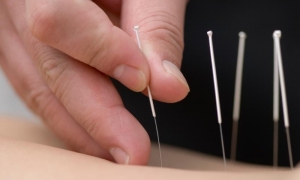 Acupuncture originated in China about 2,500 years ago and today is used to treat a wide variety of diseases, including headaches and migraines. It has been proven to provide relief for chronic disease and pain. Many points in and around the head, neck, shoulders, back, and hands can have an immediate effect on a headache. Those with chronic headaches frequently find that acupuncture is one important tool to keep their headache symptoms under control.
Acupuncture originated in China about 2,500 years ago and today is used to treat a wide variety of diseases, including headaches and migraines. It has been proven to provide relief for chronic disease and pain. Many points in and around the head, neck, shoulders, back, and hands can have an immediate effect on a headache. Those with chronic headaches frequently find that acupuncture is one important tool to keep their headache symptoms under control.
In an emergency, acupuncture can be helpful. Try pushing on one or all four of these important headache points to relieve those nasty symptoms before they steal your day. Hold each point for 2-60 seconds on the each side of the body or at least on the side of the headache.
Large Intestine
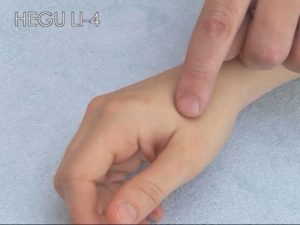
Stomach
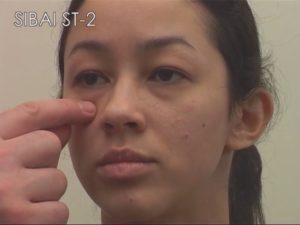
Liver
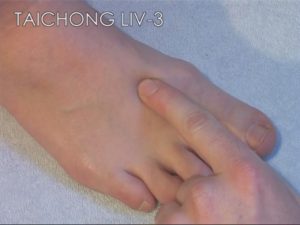
Bladder
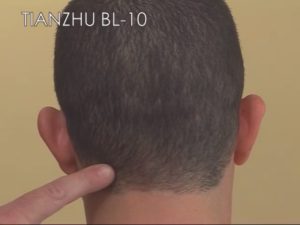
6. Dietary Changes
Dietary changes can often be helpful for stubborn and chronic headache symptoms. Many times I have found that a patient’s diet includes a soda habit, a sugar addiction, or a gluten sensitivity. These can often be the underlying cause of their headaches.
According to the National Foundation for Celiac Awareness, patients who have undiagnosed celiac disease and migraine headaches often see either the complete resolution of migraine headaches or a significant reduction in the frequency and strength of symptoms after giving up gluten. Everyone can benefit from a reduction in gluten because gluten often raises a person’s systemic inflammation levels. Start this headache remedy by eliminating gluten for three weeks, then introduce foods containing gluten slowly. Listen to your body. You will find out how much of a food group you can eat without triggering symptoms.
Spices can also be effective in reducing inflammation. Turmeric and curcumin, which are sourced from the same plant, have been researched and shown to help alleviate chronic headache symptoms. Look for recipes that use these spices, or try taking them in a capsule form.
7. Peppermint & Lavender Essential Oil
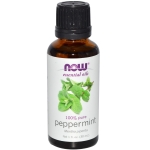 Peppermint and lavender essential oils are highly effective headache cures, as they both have a calming and numbing effect on headaches. Peppermint oil generates a long-lasting cooling effect on the skin that causes a significant increase in blood flow to the skin and muscles around the head. This creates a relaxation effect and soothes away tight muscles.
Peppermint and lavender essential oils are highly effective headache cures, as they both have a calming and numbing effect on headaches. Peppermint oil generates a long-lasting cooling effect on the skin that causes a significant increase in blood flow to the skin and muscles around the head. This creates a relaxation effect and soothes away tight muscles.
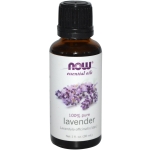 Lavender oil is has a calming and sedative effect that has been shown to greatly reduce stress, blood pressure, and headache symptoms. The effects of inhaling lavender from an essential oil diffuser has been compared to using over-the-counter pain meds and has been shown to be similarly effective. By allowing the body to relax and return to a more balanced emotional state, lavender can be one of the more effective headache cures.
Lavender oil is has a calming and sedative effect that has been shown to greatly reduce stress, blood pressure, and headache symptoms. The effects of inhaling lavender from an essential oil diffuser has been compared to using over-the-counter pain meds and has been shown to be similarly effective. By allowing the body to relax and return to a more balanced emotional state, lavender can be one of the more effective headache cures.
Because you may never know when a headache will strike, try keeping a small bottle of one or a mixture of these essential oils on hand. Inside of a small glass roll-on or spray bottle, place a few drops of the essential oils with an ounce or two of almond, grapeseed, or fractionated coconut oil. I would highly suggest using the coconut oil so that you can take advantage of its own amazing health benefits such as balancing hormones, moisturizing skin, and decreasing wrinkles.
8. Ice or heat
Headaches often respond wonderfully to ice or heat. Which therapy to use depends upon the type of headache and, frequently, the personal experience. Ice helps to reduce inflammation and calm overworked muscles. If you have a tension headache that started after activity such as carrying heavy objects, computer work, driving, or exercise, try using ice. Migraines will also respond well to ice. Both situations will respond to real ice cubes better than an ice pack. Place the ice cubes on the neck at the base of the skull for a tension headache and on the forehead for a migraine. If you are not able to ice but you want the same pain relief, try using Biofreeze. Biofreeze can be great to use when in the car, at work, or before you go to bed.
Heat in the form of a hot shower, hot tub, or infrared sauna is helpful for headaches created by fatigue or stress. These forms of heat open up blood vessels and allow tight musculature to relax loosening the grip on the head, neck, and shoulders. Do not use a heating pad, as this gives only short term relief and has the potential to increase nerve sensitivity, leading to more chronic pain and suffering.
9. Stretching and Moving
The combination of static postures and emotional stress is a powerful headache producer. The hours that each of us spend on the computer, driving, and texting on our phone can add 20-30 pounds of extra pressure to your neck and shoulders.
You can take steps to reduce this pressure by improving your ergonomic setup, but the most effective way of reducing this pressure is to simply move. Changing positions every 30 minutes can alleviate this added pressure and prevent your next tension headache or migraine.
Try this: stand up and slowly look up, simultaneously open the chest and stretch the pec muscles. Hold this position for 10-20 seconds and then repeat. You can also go for a short walk, perform 10 squats, march in place, or try some of the more advanced activities found in our “Desk Exercises” video. https://youtu.be/xXZXvfT1wEw
10. Chiropractic Care & Posture
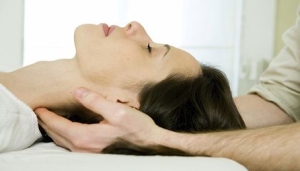 Last on our list, but perhaps the most effective tool for headaches, is chiropractic care. One of the best things about chiropractic care is that it’s a drug-free and surgery-free path to healing naturally. The chiropractic adjustment can reduce oxidative stress in the body, just like an antioxidant.
Last on our list, but perhaps the most effective tool for headaches, is chiropractic care. One of the best things about chiropractic care is that it’s a drug-free and surgery-free path to healing naturally. The chiropractic adjustment can reduce oxidative stress in the body, just like an antioxidant.
Oxidative stress is the damage that occurs when free radicals outnumber the body’s antioxidants. Oxidative stress damages all body cell components: proteins, lipids, and DNA. Oxidative stress occurs when stress residue (cortisol) is not able to be fully cleared by the body. This occurs during periods of frequent and intense stress. Oxidative stress can also build up when the diet has been poor. If you haven’t noticed, stress and poor diet frequently go together.
Chiropractic adjustments help to reduce the oxidative damage by increasing blood and neural flow to the headache-causing muscles and to the brain. Chiropractic care for headaches is so effective, it is the second most common reason why someone seeks out chiropractic for relief, just behind back pain. Research shows that chiropractic care is effective for both acute headaches and chronic headaches. If you suffer from headaches, make chiropractic care the major cure for relief and prevention.
Through May 10, stop in our Roanoke, Virginia office for 10% off pillows and supplements that help headaches: magnesium, curcumin, BioFreeze, and lavender & peppermint oils.

Daryl C. Rich, D.C., C.S.C.S.






